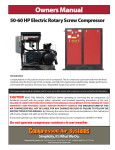Download Boss Industries 36 BHP PISTON User manual
Transcript
Service and Maintenance User Manual BOSS 36 BHP PISTON Hydraulic Air Compressor This manual must be read carefully before using your Boss Industries Air Compressor. Store in a safe and convenient location for future reference. For technical support: Phone: (800) 635-6587 (USA) Phone: (219) 324-7776 (Outside USA) Fax: (877) 254-4249 (USA) [email protected] (email) http://www.bossair.com (website) 309150 10/29/2014 KWB 2 309150 Contents Revision List........................................................................................................5 Welcome........................................................................................................6 Safety Information...............................................................................................7 Warnings, safety rules, and hazards...............................................................7 Specifications...............................................................................................10 Description of Components...............................................................................11 Installation & Operation...................................................................................12 Installation............................................................................................12 Before Starting...........................................................................................14 Initial Start-up & Test.................................................................................16 Maintenance................................................................................................17 Overview..............................................................................................17 Recommended Spare Parts List.................................................................17 Maintenance Schedule................................................................................18 Lubrication Recommendation....................................................................19 Compressor Oil .........................................................................................20 Air Intake Filter...........................................................................................20 Hydraulic Oil Cooler..................................................................................20 Piston Ring Replacement............................................................................21 Oil Pump Replacement...............................................................................23 Crankshaft and Bearing Replacement..........................................................24 Troubleshooting...........................................................................................26 General Tips..............................................................................................26 Contacting Boss Ind...................................................................................27 Where To Find Specific Machine Information.............................................27 3 309150 Warranty..............................................................................................................29 Warranty Statement....................................................................................30 Summary of Main Warranty Points..............................................................31 Return Goods Instructions.........................................................................32 Preparation of Part Return..........................................................................32 Filing Procedures.......................................................................................32 Other Info..................................................................................................33 Transit Damage..........................................................................................33 . Drawings.....................................................................................................34 Frame System............................................................................................36 Piston System............................................................................................38 Piston Assembly.........................................................................................40 Cooler System...........................................................................................42 Hydraulic Drive System..............................................................................44 Discharge System......................................................................................46 Canopy System..........................................................................................48 Decal System.............................................................................................50 Wiring Diagram..........................................................................................52 4 309150 Revision List D ATE LOCATION D ESCPR IPTION OF CHAN GE 5 IN ITIALS 309150 Welcome General Information Thank you for choosing the Boss 36 BHP Hydraulic Air Compressor. Before operating this compressor, read over this manual and become well acquainted with your new machine. Doing this will increase your safety and maximize the life of the machine. While this manual is written to be as accurate as possible, Boss strives to continually improve the efficiency and performance of its machines. As a result, sometimes there may be slight differences between a given version of the manual and the machine. Service and Maintenance User Manual BOSS 36 BHP PISTON Hydraulic Air Compressor This manual must be read carefully before using your Boss Industries Air Compressor. Store in a safe and convenient location for future reference. For technical support: Phone: (800) 635-6587 (USA) Phone: (219) 324-7776 (Outside USA) Fax: (877) 254-4249 (USA) [email protected] (email) http://www.bossair.com (website) 309150 10/29/2014 KWB Boss 36 BHP Hydraulic Air Compressor The Boss 36 BHP is a compact, strategically designed system. It integrates all major components on a single frame, which is enclosed in a tough, weather-resistant canopy. The 36 BHP Piston design provides output of up to 36 CFM (cubic feet of air per minute) at up to a maximum of 150 PSI (pounds per square inch). High output at relatively low GPM (gallons per minute) translates into the most efficient, quiet, and reliable system in its class, designed to handle virtually any application. The 36 BHP Piston also has enhanced safety features offering applications designed to protect your most valuable resource - your operating crew. To prevent overheating, a high temperature switch will shut down the machine in the event of high discharge temperatures. 6 309150 Safety IMPORTANT READ BEFORE OPERATING EQUIPMENT Remember, safety is basically common sense. While there are standard safety rules, each situation has its own peculiarities that cannot always be covered by rules. Therefore with your experience and common sense, you are in a position to ensure your and others safety. Lack of attention to safety can result in: accidents, personal injury, reduction in efficiency and worst of all – Loss of Life. Watch for safety hazards and correct them promptly. Understanding the proper operation of this equipment is critical to its safe operation. The owner, lessor or operator of this equipment is hereby notified and forewarned that any failure to observe the safety and operating guidelines may result in injury and/or damage. Boss expressly disclaims responsibility or liability for any injury or damage caused by failure to observe these specified precautions or by failure to exercise the ordinary caution and due care required while operating or handling this equipment, even though not expressly specified. In addition to following these safety guidelines, the operator should follow any company specific guidelines and procedures. Consult your immediate supervisor for specific company safety guidelines and/or procedures. The following safety symbols are used throughout the manual to draw attention to important information. If the information is not carefully read and the instructions are not followed, severe injury, death, and/or damage to property and equipment may occur. Indicate[s] an imminently hazardous situation, which, if not avoided, will result in death or serious injury. Indicate[s] a potentially hazardous situation, which, if not avoided, could result in death or serious injury. Indicate[s] a potentially hazardous situation, which, if not avoided, could result in minor or moderate injury. Indicate[s] a potentially unsafe situation or practice, which, if not avoided can result in property and/or equipment damage only. 7 309150 Safety The following safety precautions are a general guide to safe operation of the equipment. Read and understand the operations manual and all other safety instructions before using this equipment. Failure to follow operating instructions and/or failure to follow maintenance procedures and intervals could result in personal injury, death, and/or damage to equipment and property. Pressurized System. Do not attempt to remove any compressor parts without first completely relieving entire system of pressure. Do not attempt to service any part of the equipment while in operation. Never attempt to repair or modify any pressure vessel or device. System contains hot oil. The compressor system must be shut off prior to servicing. Open the service valve to ensure complete relief of system air pressure and stored energy. Then permit system to cool down prior to adding compressor oil or servicing the unit. Do not use air from this compressor for breathing or food processing. Air from this compressor will cause severe injury if used for breathing or food processing. The compressor is designed to compress air only. Do not attempt to compress other gases. Compression of other gases may create a situation where an explosion or fire may occur. Do not use flammable solvents for cleaning compressor parts as this can cause the unit to ignite or explode during operation. Keep combustibles out of and away from compressor inlet, and any associated enclosures. 8 309150 Safety Never disable, override, or remove safeties, either temporarily or permanently. Connect air hoses only in full compliance with OSHA Standard 29 CFR 1926:302 (b)(7). The required safety devices (velocity fuses) should be tested in accordance with their manufacturer’s recommendations to verify that they reduce pressure in case of hose failure and will not nuisance trip with the hose and tool combinations in use. Failure to comply could result in personal injury or death and/or damage to equipment and property. Never leave the machine running unattended or leave a tool connected to an air hose when not using. Relieve system of all stored air pressure after use. Never adjust the pressure switch to a setting of greater than 150 PSI. Operating the compressor at greater than 150 PSI may result in personal injury and property damage. Mount the compressor in a stable location capable of supporting 180 lbs. Slight vibration may occur during operation and the machine may move if not securely mounted. When using tools, maintain secure footing at all times. Do not overreach or awkwardly use air tools. Prior to moving vehicle to the next work site, drain the air tank. To prevent the collection of water in the tank drain daily. Use only Boss approved replacement parts. 9 309150 Specifications POWER SOURCE HYDRAULIC MOTOR OPERATING SPEED 1400 RPM MAX. CYLINDER CONFIG. V4 Piston OIL CAPACITY 1 1/3 QTS DIM ENSIONS 28 1/2"L x 17 3/4"H x 20 7/8"W WEIGHT 180 LBS. DELIVERY @ 100 PSI 36 C F M HYDRAULIC RESERVOIR REQ. * 20 GALLON MINIMUM COOLING AIR NORM AL GPM @ 1400 RPM 9.39 GPM FAN DIAM ETER 14 1/8" NORM AL OPERATING PSI 1850 P S I M AXIM UM PSI 2400 PSI * Hydraulic reservoir requirement for compressor only. Additional capacity will be needed to other hydraulic equipment. SPECIFICATIONS SUBJECT TO CHANGE WITHOUT PRIOR NOTICE 17 3/4 in [451.5 mm] 20 7/8 in [529.6 mm] 28 1/2 in [723.9 mm] 1/2 in [12.7 mm] – 36 BHP system is to run intermittently. – When the 36 BHP is installed with other hydraulic drive equipment it will require a dedicated flow line. – If other hydraulics are required, the reservoir size should be at least 20 GAL for the 36 BHP plus all the other manufacturer’s requirements. – Mounting surface must be capable of 180 lbs. load spread over the four mounting holes. – Cooling air intake must not see air temperatures above ambient. – Cooling air discharge must have 10” clearance from any obstructions. – Ambient running conditions: -20° to 100° F. – 20° maximum operating slope. 10 309150 Description of Components Compressor Assembly - The Boss 36 BHP hydraulic drive piston compressor assembly is a positive displacement, intermittent-flow, reciprocating unit. The piston compressor consists of a crankshaft, oil filter, oil pump, four connecting rods, pistons, cylinders, and valve assemblies. As the crankshaft rotates, the pistons move up and down. As they move down, a vacuum is created above the piston which allows the reed valve to open and fill the area above the piston with air. When the pistons move back up, this air is discharged from the compressor. Oil lubricates the bearings and cylinder walls as the crankshaft rotates, ensuring that the system stays cool. Hydraulic Oil Cooling Systems - The compressor cooling system consists of a hydraulic cooler mounted on the compressor frame. Cool air is drawn through the vented end panel and flows over the compressor surface and through the hydraulic cooler, exiting out the front vented panel . Allow for adequate clearance (10”) for the air to exit. Also, the package location should not be subjected to air temperatures above ambient. Fluid Level Sight Glass - This sight glass indicates the fluid level in the crank case. Proper level should be in the middle of the sight glass. Check this level when the compressor is disengaged and the vehicle is parked on level ground. Fluid level should be checked prior to each use. Electrical System - The Boss compressor’s standard electrical system consists of: -Hydraulic oil cooler fan assembly and relay. -12VDC N.O. hydraulic solenoid. -Switch relay for customer equipment interface during compressor operation. Most air tools operating pressure range is between 90 and 125 psi. Operating above the tools’ recommended pressures will decrease the life of the tool. Higher operating pressure can also over torque nuts and bolts fatiguing the fastener and mating parts. Strictly adhere to tool operating pressures and torque standards set forth by the tool manufacturer and the specifications of the equipment that work is being performed on. Pressure Switch - The pressure switch is a N.C. electrical switch set to open at 150 PSI and set to close at 115 PSI. The pressure switch controls the N.O. hydraulic solenoid. If service air pressure is under 150 PSI, the pressure switch will remain in its normally closed state, keeping the N.O. hydraulic solenoid closed and the compressor producing air. If the service valve is closed or the tool using the air is off, service line pressure will rise to 150 PSI. This will cause the pressure switch to open and deactivate the hydraulic solenoid. The compressor will stop making air. If the tool is turned on or the service valve is opened, the service line pressure will drop. When the pressure falls to 115 PSI, the pressure switch will close, energizing the N.O. hydraulic solenoid forcing flow to the motor and the compressor will start producing air to meet the demand. Never adjust the pressure switch to a setting of greater than 150 PSI. Operating the compressor at greater than 150 PSI may result in personal injury and property damage. 11 309150 Installation & Operation This air compressor should be installed only by those who have been trained and delegated to do so and who have read and understand the manual. Failure to follow the instructions, procedures, and safety precautions in this manual may result in accidents and injuries. Install, use, and operate this air compressor only in full compliance with all pertinent O.S.H.A., Federal, State, and Local codes or requirements in addition to Boss and any company’s regulations. Do not modify this compressor except with written factory approval. ALL TRUCKS SHOULD BE ROAD TESTED PRIOR TO STARTING INSTALLATION TO ISOLATE ANY PREVIOUS TRUCK PROBLEMS. 1. Mounting the Compressor When mounting the compressor care should be taken to ensure that its location does not impede the operation of other components on the vehicle. For example, if your vehicle is equipped with a crane, you must make sure the compressor will not interfere with the swing of the crane. In addition, the compressor should be installed in an area that permits cool ambient air to enter the air filter and the hot air to exhaust without recirculating into the air filter. 10” of exhaust clearance is needed. The compressor air filter is mounted on the frame. Cool ambient air is drawn in from under the frame. One last consideration in the mounting should be the routing of hoses and electrical wires. The frame mounting holes are shown below and the unit should be secured to the vehicle with 3/8 inch grade 8 bolts and washers. Hardware supplied with unit, may not work in all applications. The compressor weighs 180 lbs. Ensure that you have a sub structure to support at least that weight. Be sure to follow all National Vehicle Safety Standards. 12 309150 Installation & Operation 2. Installing the Wiring This unit is shipped from the factory with all necessary internal wiring installed. The only remaining wiring necessary is the wiring needed to interface your vehicle/power source with the Boss compressor. The unit is shipped with a 4 pin connector, they need to be connected as follows: 1. Pin “A” and Pin “E” are to be connected directly to battery positive (Pin “A”) and battery negative (Pin “E”). 2. Compressor Only: for normal compressor operation, supply 12VDC inputs to Pin “C”. This will activate the system and pressure the tank to 150 PSI. The system will then unload until the tank has dropped to 110 PSI, at which point it will automatically activate. The 12VDC output signal from Pin “D” will be present only when the system is compressing. 3. Connecting the Hydraulic Hoses The hydraulic hoses to the compressor should be connected directly to the hydraulic fittings. The fittings are 3/4” JIC. The pressure “P” input line should be made from a good quality high pressure hydraulic hose 1/2” or 3/4” I.D. rated to handle the hydraulic systems on the vehicle. The return line to tank “T” can be made from a medium pressure (min. 1000 PSI) hydraulic hose 3/4” I.D. Care should be taken to see that the hoses are not installed with kinks or bends that inhibit flow of the hydraulic oil. Lack of flow could result in damage to the motor and compressor. Lastly check to make sure hoses are not in contact with sharp objects or edges that may fray, chafe or cut them over time. Secure all hoses with tie down straps or clamps. 4. Connecting the Air Hose The air discharge hose should be connected directly to the “AIR” port. The fitting is a 3/4” female NPT. The air line should be made from a good quality (min. 200 PSI) hydraulic hose 1/2” or 3/4” I.D. Care should be taken to see that the hose is not installed with kinks. When adding an air hose, ensure OSHA Regulation 1910.169 is followed. HYDRAULIC PRESSURE IN HYDRAULIC TANK OUT AIR OUT 13 309150 Installation & Operation A compressor service valve should be located at the hose reel inlet or the customer’s air connection port when a hose reel is not used. Typical plumbing from the machine’s air outlet port occurs in the following order: 1. Air tank 2. OSHA valve. 3. Service valve. 4. Moisture trap/gauge/oiler combination (when used). 5. Hose reel (when used). 5. Pre-Start-up Inspection Checks This inspection should be done prior the compressor test. I. Check all assemblies, clamps, fittings, hose connections, nuts, and bolts to ensure they are properly tied and secured to the vehicle. This is a very critical area of inspection. The vehicle should not be moved until this inspection has been completed. II. Remove all tools, rags, and installation equipment from the area. III. Check compressor oil level and hydraulic fluid level. Check all valves to ensure they are in correct operating position. IV. Apply decals to proper location. Make sure that the area is cleaned prior to applying decals. All decals should have a professional appearance upon application. V. Vacuum all areas that have metal or plastic shavings. Wipe all fingerprints off unit and vehicle. 14 309150 Installation & Operation V. Record all serial numbers for this installation. A. Vehicle V.I.N. ___________________________________________________________________________ B. Hydraulic Pump Data ___________________________________________________________________________ C. Compressor Serial Number ___________________________________________________________________________ D. Boss Serial Number ___________________________________________________________________________ E. Air Tank Serial Number ___________________________________________________________________________ F. Note any special applications relating to specific installations. ___________________________________________________________________________ VI. Check all fluid levels (position the unit on a level surface so that proper amount of fluids can be added). A. Fuel to provide three hours of operation. B. Hydraulic fluid levels may have to be topped off after test. C. Compressor. Check the compressor oil level (see lubricant section of the operator and parts section for type of lubricant to use). 1. Add oil if needed. 2. Additional oil may need to be added after test. 3. Top off oil level to half the sightglass when finished with the test. D. Any other applicable fluids. E. Transmission fluid and PTO box. 15 309150 Installation & Operation 6. Operating Procedure I. Read the operation section in the manual carefully before proceeding onto the initial start-up. II. Start power source and allow for warm-up. III. Verify the compressor is disengaged. IV. Engage hydraulic system per company policy. V. Engage compressor. 7. Shutdown Procedure I. Disengage compressor circuit. II. Relieve system of stored air. Operating Conditions The following conditions should exist for maximum performance of the compressor. The truck should be as close to level as possible when operating. Operation in ambient temperatures above 100°F (38°C) may experience high temperature shutdown. 16 309150 Maintenance This section contains instructions for performing the inspection, lubrication, and maintenance procedures required to maintain the compressor in proper operating condition. The importance of performing the maintenance described herein cannot be over emphasized. The periodic maintenance procedures to be performed on the equipment covered by this manual are listed on the following page. It should be understood that the intervals between inspections specified are maximum interval. More frequent inspections should be made if the unit is operating in a dusty environment, in high ambient temperature, or in other unusual conditions. A planned program of periodic inspection and maintenance will help avoid premature failure and costly repairs. Daily visual inspections should become a routine. Compressor must be shut down and completely relieved of pressure prior to checking fluid levels. Open service valve to ensure relief of system air pressure. Relieve all stored air pressure energy prior to starting machine. Failure to comply with this warning will cause damage to property and serious bodily harm. Recommended Spare Parts List PART NUMBER DESCRIPTION 80186 KIT, REPAIR REED VALVE 308157 ELEMENT, AIR FILTER 301267 SPIDER, CURVED JAW 302936 KIT, REPAIR HYD MOTOR SEAL 308245 LUBRICANT, 2QT BOX SYNTH How To Order Parts For Parts and/or Service Support: Phone: (800) 635-6587 (USA) Phone: (219) 324-7776 (Outside USA) Local Fax: (877) 254-4249 [email protected] (email) http://www.bossair.com (website) 17 309150 Maintenance The LUBRICATION AND MAINTENANCE CHART lists serviceable items on this compressor package. The items are listed according to their frequency of maintenance, followed by those items which need only “As Required” maintenance. Lubrication and Maintenance Chart SERVICE INTERVAL M AINTENANCE OPERATION DAILY 1. Check crankcase oil level. Add if needed. 2. Drain condensation from air receiver. WEEKLY 1. Inspect the air intake. 2. Check the cylinder head stud torque (see NOTE 2). 3. Check the operation of the receiver safety valves. EVERY 3 MONTHS 1. Change the crankcase oil (see NOTE 1). 2. Check cooler fins for dirt and obstruction. Clean if needed. EVERY 6 MONTHS 1. Inspect the drive coupling for wear. 2. Change the air cleaner. Use only Boss’ synthetic compressor oil. The use of any other oil causes excessive carbon buildup, and may void the warranty on the compressor. NOTE 1. Under normal operating conditions, oil changes are required every 3 months. When operating in a dirty environment, change the oil and air filter more frequently as your particular operating conditions dictate. Compressor oil capacity is 1-1/3 quarts. NOTE 2. Cylinder head stud torque MUST be checked after the initial day of operation. The compressor must be cold (room temperature) before re-torquing of studs. Torque studs to 240 in-lbs plus or minus 10 in-lbs. 18 309150 Maintenance Lubrication Recommendations It is important that the compressor oil be of a recommended type and that this oil as well as the air filter element be inspected and replaced as started in this manual. The following are general characteristics for a piston lubricant. Due to the impossibility of establishing limits on all physical and chemical properties of lubricants which can affect their performance in the compressor over a broad range of environmental influences, the responsibility for recommending and consistently furnishing a suitable heavy duty lubricant must rest with the individual supplier if they choose not to use the recommended Boss Piston lubricant. The lubricant supplier’s recommendation must, therefore, be based upon not only the following general characteristics, but also upon his own knowledge of the suitability of the recommended lubricant in piston air compressors operating in the particular environment involved. UNIT METHOD RATING ISO VISCOSITY GRADE ISO 3448 46 KINEMATIC VISCOSITY ASTM D445 - AT 40°C (104°F) mm2/s 46 - AT 100°C (212°F) mm2/s 7. 7 DENSITY AT 15°C (59°F) g/mL ASTM D1298 .843 FLASH POINT (COC) °C (°F) ASTM D92 235 (455) POUR POINT °C (°F) ASTM D97 <- 45 (- 49) VISCOSITY INDEX (VI) DIN ISO 2909 135 RUST PREVENTION PROPERTIES ASTM D665- B PASS WATER SEPERABILITY min ASTM D1401 10 ROTATING PRESSURE VESSEL OXIDATION TEST min ASTM D2272 2200 FAILURE LOAD STAGE CEC- L- 07- A- 95 >12 FZG LOAD CARRYING TEST Mixing different types or brands of lubricants is not recommended due to the possibility of a dilution of the additives or a reaction between additives or different types. 19 309150 Maintenance Due to environmental factors, the useful life of all “extended life” lubricants may be shorter than quoted by the lubricant supplier. Boss encourages the user to closely monitor the lubricant condition and to participate in an oil analysis program with the supplier. No lubricant, however good and/or expensive, can replace proper maintenance and attention. Select and use it wisely. Compressor Oil Fill, Level, and Drain Before adding or changing compressor oil, make sure that the compressor is completely relieved of pressure. Oil is added at the fill cap on the side of the compressor body. A drain line is located opposite the service door. The proper oil level is in the middle of the oil sightglass, when the unit is shut down and has had time to settle. The truck must be level when checking the oil. DO NOT OVERFILL. The oil capacity is given in “Compressor Specifications”. Do not attempt to drain condensate, remove the oil level fill cap, or break any connection in the air or oil system without shutting off the compressor and relieve the system of all stored air pressure. Air Intake Filter (P/N 308157) The air intake filter is a heavy-duty dry type high efficiency filter designed to protect the compressor from dust and foreign objects. Frequency of maintenance of the filter depends on dust conditions at the operating site. The filter element must be serviced when clogged. A clogged air filter element will reduce compressor performance and cause premature wear of components. Hydraulic Oil Cooler The interior of the oil cooler should be cleaned when the pressure drop across it at full flow exceeds 25 PSI. 1. 2. 3. 4. Remove cooler. Circulate a suitable solvent to dissolve and remove varnish and sludge. Flush generously with hydraulic oil. Once the cooler is reinstalled, fill the hydraulic system with the proper fluid to their appropriate levels. 20 309150 Maintenance This following pages describe the disassembly and assembly procedures for the air compressor. In all cases, remove the compressor from the vehicle before proceeding with disassembly and repair within a clean environment. Refer to the parts drawings in this manual for parts locations. 1. Piston Ring Replacement I. Shut down machine and allow to cool for approximately 10 minutes. II. Verify entire system pressure is relieved before proceeding. III. Disconnect air inlet system tubes. IV. Disconnect 3/4" discharge jumper hose. V. Disconnect 3/4" discharge hose. VI. Disconnect 1/4" furnace switch tube. VII. Unscrew the head nuts and remove the heads. A rubber faced mallet will help when removing the head. Tap the sides of the head carefully until the head is loose. Lift off the heads. VIII. Remove the cylinder bolts. Tap the sides of the cylinder several times to break it loose from the gasket. Rock the cylinder back and forth and lift until it is free. Lift it off the pistons. IX. Use a single edged razor blade, or sharp putty knife, to remove the old gasket material. Do not allow the gasket material to fall into the crankcase. Do not nick the head, cylinder, or crankcase mating faces while removing the old gasket. Remove all of the old gasket material to provide a smooth, clean surface for the new gasket. Failure to follow this procedure may result in the need to reseal the unit later. X. Hone the cylinder to break the glaze and to remove the buildup at the top of the cylinders. XI. Measure the inside diameter of the cylinder for roundness and excessive wear. The bore should be 2.625" (0.0025" tolerance). If the bore is oversized, the cylinder must be replaced. XII. With a ring expander, remove the compression and oil rings. XIII. With the ring expander, install the new ring kit. Make certain that the oil ring is on the bottom and the beveled inside edge of the compression ring is toward the top of the piston. XIV. Position the cylinder base gasket on the crankcase. Use a few drops of oil to hold it in position. Install the cylinder block spacer and gasket on the crankcase. 21 309150 Maintenance XV. Rotate the rings so that the gaps of the three rings are 120° apart. See Fig. 1. Lightly lubricate the inside of the cylinder. Rotate the crankshaft so that a piston is at the top of the stroke. Compress the rings with a ring compressor, and slide the cylinder over the piston. Repeat for the other piston. Do not lubricate the rings. Use a light lubricant, such as WD-40 only, on the cylinder walls. Oiling the rings will prevent them from seating and cause excessive oil consumption. FIGURE 1. PISTON RING ORIENTATION XVI. Slide the cylinder down until it mates with the crankcase. Start all cylinder mounting bolts, until they are snug. Torque the bolts to 180 in-lbs in the sequence shown. Do not torque to the full 180 in-lbs all at once, but in 25-50 in-lb increments. See Fig. 2. 180 IN-LBS FIGURE 2. CYLINDER MOUNTING BOLT TORQUE SEQUENCE XVII. Position the gaskets and valve plate on top of the cylinder. Position the head on the cylinder and turn bolts finger tight. Torque the studs/nuts to 240 in-lbs in 25-50 pound increments. See Fig. 3. 22 309150 Maintenance FIGURE 3. CYLINDER HEAD TORQUE SEQUENCE XVIII. Reconnect the 3/4" discharge hose and discharge jumper hose. XIX. Reconnect the 1/4" furnace switch tube. XX. Install the compressor and connect the wiring. XXI. Test the machine. If pressure fails to build and the compressor is excessively noisy, check the valve plate. It may have been installed upside down. 2. Oil Pump Replacement I. Shut down machine and allow to cool for approximately 10 minutes. II. Verify entire system pressure is relieved before proceeding. III. Remove the bolts and lift off the pump cover. IV. With a single edged razor blade, or sharp putty knife, remove the old gasket material. Take care not to damage the machined surfaces. Do not allow the gasket material to fall into the crankcase. Do not nick the head, cylinder, or crankcase mating faces while removing the old gasket. Remove all of the old gasket material to provide a smooth, clean surface for the new gasket. Failure to follow this procedure may result in the need to reseal the unit later. V. Lift the pump out of the cavity. VI. Position a new gasket on the rear bearing housing. VII. Insert the pump into the cavity. Position the pump slightly to one side, using a common screwdriver. Wedge the pump into position so that it partially compresses the spring. Note that the driver pin and slot in pump must be in line. 23 309150 Maintenance VIII. Place the pump cover into position and start two bolts (bolts must be diagonally opposed). Strike the pump cover with a rubber faced mallet to jar the pump loose. When the tension spring can be felt against the pump cover, the pump is loose. IX. Insert the two remaining bolts and torque to 180 in-lbs. The bolts should be torqued in a diagonal pattern. X. Install the air compressor in the vehicle. Connect the air lines and wiring. 3. Crankshaft and Bearing Replacement If it is necessary to replace the crankshaft, related components must also be replaced. Replace both bearings, both races, the key, pump collar and pump drive pin. Depending on the condition of the crankshaft, bearing may be replaced without replacing the crankshaft. Replace the bearing races whenever the bearings are replaced. I. Shut down machine and allow to cool for approximately 10 minutes. II. Verify entire system pressure is relieved before proceeding. III. Remove both heads, cylinders, and pistons. See Piston Ring Replacement on P. 21. IV. Remove the bolts on the connecting rods, and lift them out. Reassemble the connecting rods to be certain that the matched parts remain together on the same crankshaft journals. V. Remove the pump cover, oil pump, sleeve, spring, and rear bearing housing. VI. Remove the drive hub, and the front bearing housing. VII. Pull the crankshaft from the crankcase. VIII. Remove all gasket material with a single edged razor blade, or sharp putty knife. Do not allow the gasket material to fall into the crankcase. Do not nick the head, cylinder, or crankcase mating faces while removing the old gasket. Remove all of the old gasket material to provide a smooth, clean surface for the new gasket. Failure to follow this procedure may result in the need to reseal the unit later. Do not gouge the machined surfaces when removing the gaskets. This may cause leaks. IX. Press the bearing races out of the bearing housing. 24 309150 Maintenance X. Press the tapered roller bearings off of the crankshaft if only the bearings are being replaced. If the crankshaft is to be replaced, discard the entire assembly. XI. Press the new bearings into position. XII. Generously oil the front bearing race and install the front bearing housing with gasket. Torque the bolts to 180 in-lbs. Torque the bolts as shown in the pattern below. The crankshaft should have new bearings installed. If not, press the new bearings into position on the crankshaft. FIGURE 4. BEARING HOUSING TORQUE SEQUENCE XIII. Slide the crankshaft into the crankcase. Generously lubricate the bearing race and install the rear bearing housing and gaskets. Gasket kits are supplied with two (2) each of .006, .010, .015, and .020 gaskets. Use these rear bearing gaskets in any combination and quantity to limit all play front to rear, but still allow the crankshaft to turn freely. XIV. Install the oil pump. XV. Install the connecting rods. Thoroughly oil the crankshaft and rods before installing them. When installing the rods, make certain that the tabs are aligned on the same side of the rod, see Fig. 4. XVI. Install the pistons, rings and heads. See Piston Ring Replacement on P. 21. FIGURE 5. ROD ALIGNMENT 25 309150 Troubleshooting The troubleshooting procedures to be performed on the equipment are listed below. Each symptom of trouble for a component or system is followed by a list of probable causes of the trouble and suggested procedures to be followed to identify the cause. In general, the procedures listed should be performed in the order in which they are listed, although the order may be varied if the need is indicated by conditions under which the trouble occurred. In any event, the procedures which can be performed in the least amount of time and with the least amount of removal or disassembly of parts, should be performed first. LOW OIL PRESSURE 1. 2. 3. 4. Low oil level. Loose pipe plug on oil pump cover. Worn or defective oil pump. Crack or scratch on oil pump cover. NO OIL PRESSURE 1. Defective oil pump 2. Blocked oil passage. 3. Damage oil pump drive pin. COMPRESSOR WILL NOT ENGAGE 1. 2. 3. 4. No power supplied to compressor. Internal circuit breaker tripped. Hydraulic system not engaged. Defective pressure switch. COMPRESSOR ENGAGES BUT WILL NOT PRESSURIZE TANK 1. Air leak in plumbing. 2. Worn piston rings or valve plates. COMPRESSOR DOES NOT RECOVER PRESSURE AS FAST AS IT SHOULD 1. Dirty filter. 2. Air leak in plumbing. 3. Worn valve plates or piston rings. 26 309150 Troubleshooting Contacting Boss Industries, Inc. Local Phone: (800) 635-6587 Local Fax: (877) 254-4249 http://www.bossair.com When calling for technical support, have the following information available: Machine Serial Number Description of the problem How To Find Specific Machine Information The machine serial number can be found on the Boss serial tag located on the side of machine. 27 309150 28 309150 WARRANTY SECTION 29 309150 Warranty Boss Industries, Inc. warrants that this Piston Compressor unit conforms to applicable drawings and specifications approved in writing by Boss Industries, Inc.. The unit assembly will be free from defects in material and workmanship for a period of one (1) years from the date of initial operation or eighteen (18) months from the date of shipment, whichever period first expires. All other components and parts of Boss Industries, Inc. manufacture, will be free from defects in material and workmanship for a period of one (1) year from the date of initial operation or eighteen (18) months from the date of shipment, whichever period first expires. If within such period Boss Industries, Inc. receives from the Buyer written notice of and alleged defect in or nonconformance of the unit, all other components and parts of Boss Industries, Inc. manufacture and if in the judgment of Boss Industries, Inc. these items do not conform or are found to be defective in material of workmanship, Boss Industries, Inc. will at its option either, (a) furnish a Service Representative to correct defective workmanship, or (b) upon return of the item F.O.B. Boss Industries, Inc. original shipping point, repair or replace the item or issue credit for the replacement item ordered by Buyer, (Defective material must be returned within thirty (30) days of return shipping instructions from Boss Industries, Inc.. Failure to do so within specified time will result in forfeiture of claim), or (c) refund the full purchase price for the item without interest. Factory installed units will also include warranty on installation for a period of one (1) year. This warranty does not cover damage caused by accident, misuse or negligence. If the compressor unit is disassembled the warranty is void. Boss Industries, Inc. sole responsibility and Buyer’s exclusive remedy hereunder is limited to such repair, replacement, or repayment of the purchase price. Parts not of Boss Industries, Inc. manufacture are warranted only to the extent that they are warranted by the original manufacture. Boss Industries, Inc. shall have no responsibility for any cost or expense incurred by Buyer from inability of Boss Industries, Inc. to repair under said warranty when such inability is beyond the control of Boss Industries, Inc. or caused solely by Buyer. There are no other warranties, express, statutory or implied, including those of merchantability and of fitness of purpose; nor any affirmation of fact or representation which extends beyond the description of the face hereof. This warranty shall be void and Boss Industries, Inc. shall have no responsibility to repair, replace, or repay the purchase price of defective or damaged parts or components resulting directly or indirectly from the use of repair or replacement parts not of Boss Industries, Inc. manufacture or approved by Boss Industries, Inc. or from Buyer’s failure to store, install, maintain, and operate the compressor according to the recommendations contained in the Operating and Parts Manual and good engineering practice. The total responsibility of Boss Industries, Inc. for claims, losses, liabilities or damages, whether in contract or tort, arising out of or related to its products shall not exceed the purchase price. In no event shall Boss Industries, Inc. be liable for any special, indirect, incidental or consequential damages of any charter, including, but not limited to, loss of use of productive facilities or equipment, loss of profits, property damage, expenses incurred in reliance on the performance of Boss Industries, Inc., or lost production, whether suffered by Buyer or any third party. Boss Industries, Inc. 1761 Genesis Drive LaPorte, IN 46350 30 309150 Warranty Summary of Main Warranty Provisions As claims, policies and procedure are governed by the terms of the Boss Industries, Inc. warranty, it is necessary to outline some of the more important provisions. The Boss Industries, Inc. warranty applies only to new and unused products which, after shipment from the factory, have not been altered, changed, repaired or mistreated in any manner whatsoever. Normal maintenance items such as lubricants and filters are not warrantable items. Parts not of Boss Industries, Inc. manufacture are warranted only to the extent they are warranted by the original manufacturer. Damage resulting from abuse, neglect, misapplication or overloading of a machine, accessory or part is not covered under warranty. Deterioration or wear occasioned by chemical and/or abrasive action or excessive heat shall not constitute defects. Parts replacement and/or correction of defective workmanship will normally be handled by Boss Industries, Inc. or their authorized distributor. Failure to file a detailed warranty claim/service report for each occurrence of material defect of defective workmanship will cause warranty claim to be rejected. Defective material must be returned within 30 days of receipt of shipping instructions. Failure to do so within specified time will result in forfeiture of claim. The distributor is responsible for the initial investigation and write up of the warranty claim. Distributor shall be allowed no more than 30 days from date of repair to file a warranty claim/service report. Warranty for failure of Boss Industries, Inc. replacement parts covers the net cost of the part only, not labor and mileage. The Boss Industries, Inc. warranty does not cover diagnostic calls and travel. That is time spent traveling to the machine to analyze the problem and returning with the proper tools and parts to correct the problem. Boss Industries, Inc. will deduct from allowable credits for excess freight caused by sender failing to follow return shipping instructions. Distributors or end-users automatically deducting the value of a warranty claim from outstanding balances due and payable to Boss Industries, Inc. prior to receiving written notification of Boss Industries, Inc. approval of the warranty claim may be subject to forfeiture of the entire claim. 31 309150 Warranty Warranty/Return Goods Instructions The warranty/return procedure outlined below is provided to give the claimant the information necessary to file a warranty/return claim, and enable Boss Industries, Inc. the ability to best serve its’ customers. Please see the following instructions to initiate a return: Contact Boss Industries, Inc. Returns Department by telephone at 800-635-6587 . You may also send a fax at 877-254-4249. Warranty Claims - Preparation of Part Return Parts returned to the factory must be properly packaged to prevent damage during shipment. Damage to a part as a result of improper handling or packing could be cause for denial. When addressing the package for shipment, the following information must be on the outside of, or tagged clearly, to the package. 1. 2. 3. 4. Return Goods Authorization #. Distributor or end-users return address. Correct factory address. Number of packages pertaining to each claim. NOTE: Our warranty requires that all defective parts be returned to Boss Industries, Inc. freight prepaid. Items sent without RGA number will not be accepted. Unauthorized Returns Will Immediately Be Refused At Dock. Return or Warranty Claims - Filing Procedures 1. Initiate through a purchase order for warranty part or request for credit. 2. RGA will accompany replacement part. 3. Boss Industries, Inc. will confirm disposition of failed part within 30 days of receipt and or request additional information. 4. Claim denial will result in issuance of a letter of denial. 5. Boss Industries, Inc. will consider each claim on its’ own merit and reserves the right to accept or reject claim request. 6. Send Warranty Claim to: Boss Industries, Inc. 1761 Genesis Drive LaPorte, IN 46350 32 309150 Warranty General An approved claim depends on the following provision: 1. An RGA # must be issued by Boss Industries, Inc.. (See filing procedures.) 2. Failed part must be returned within 30 days of original invoice date, freight prepaid, with RGA #. 3. Part is determined to be defective. 4. Workmanship is determined to be defective. 5. Machine is within warranty period. 6. Machine has been operated within design conditions. Claims made through distributors must be verified by distributor prior to contacting Boss Industries, Inc.. Damage in Transit Do not return damaged merchandise to Boss Industries, Inc., please follow claim procedure. 1. Loss in transit: The merchandise in our kit or provided in our factory installations has been thoroughly inspected or carefully installed and tested before leaving our plant. However, regardless of the care taken at the factory, there is a possibility that damage may occur in shipment. For this reason, it is recommended that the unit be carefully inspected for evidence of possible damage or malfunction during the first few hours of operation. Responsibility for the safe delivery of the kit or factory installed unit was assumed by the carrier at the time of shipment. Therefore, claims for loss or damage to the contents of the kit or factory installed unit should be made upon the carrier. 2. Concealed loss or damage: Concealed loss or damage means loss or damage, which does not become apparent until the kit is unpacked or the factory-installed unit is run by the end-user. The contents of the kit or factory installed unit may be damaged due to rough handling while in route to its destination, even thought the kit or factory installed unit shows no external damage. When the damage is discovered upon unpacking, make a written request for inspection by the carrier agent within fifteen days of delivery date. Then file a claim with the carrier since such damage is the carrier’s responsibility. By following these instructions carefully, we guarantee our full support of your claims, to protect you against loss from concealed damage. 3. Visible Loss or Damage Any external evidence of loss or damage must be noted on the Freight Bill or Express Receipt, and signed by the carrier’s agent. Failure to adequately describe such external evidence of loss, or damage may result in the carrier refusing to honor a damage claim. The carrier will supply the form required to file such a claim. 33 309150 34 309150 PARTS AND ILLUSTRATION SECTION 35 309150 Frame System ITEM QTY 1 2 3 4 5 6 7 8 9 10 11 12 13 14 15 16 1 6 1 1 1 1 1 1 2 2 1 1 1 2 2 2 Parts List PART NUMBER 308081 961504-090 943103-025 302613 938206-071 308216 308217 929806-100 931702-050 300211 304957 937806-094 308218 938604-071 938004-062 929104-075 36 DESCRIPTION FRAME NUT RIVET CLIP WASHER ADAPTER FILTER BOLT SCREW RELAY CLAMP WASHER BRACKET WASHER WASHER BOLT 309150 Frame System 6 8 7 12 5 3 11 4 1 16 15 14 13 10 2 9 37 309150 Piston System ITEM QTY 1 2 3 4 5 6 7 8 9 10 11 12 13 14 15 16 17 18 19 20 21 22 24 25 26 27 28 4 1 1 1 1 2 1 2 1 1 1 1 1 1 4 4 4 2 1 1 1 1 1 2 1 2 1.5 FT Parts List PART NUMBER 902915-030 300783 907604-030 960212-075 906915-040 902915-040 906030-020 307440 901115-020 902203-032 961912-075 40020 960816-100 990512-075 938206-071 929806-150 937806-094 922212-000 308149 301142 975104-012 301578 902615-030 308214 308215 960012-075 302636 38 DESCRIPTION PLUG SIGHTGLASS BUSHING ELBOW TEE PLUG CAP FITTING ELBOW TEE TEE PISTON ASSY ELBOW ELBOW WASHER BOLT WASHER NIPPLE CAP VALVE ELBOW SWITCH ELBOW ELBOW ADAPTER ELBOW HOSE 309150 Piston System 27 4 11 1 14 20 1 21 25 22 18 1 18 24 10 16 6 27 17 15 19 26 3 13 25 1 5 2 12 9 8 28 8 7 39 309150 Piston Assembly ITEM QTY 1 2 3 4 5 6 7 8 9 10 11 12 13 14 15 16 17 18 19 20 21 22 23 24 25 26 27 28 29 32 33 34 35 36 37 38 39 40 41 42 43 44 45 46 47 48 49 4 4 8 4 1 1 1 1 1 1 1 1 17 5 1 1 1 2 3 1 1 1 1 1 12 1 2 9 12 12 1 1 2 2 1 2 12 1 1 2 1 2 2 4 1 1 1 Parts List PART NUMBER 308336 308119 308120 308121 308122 308123 308124 308125 308126 308127 308128 308129 929105-100 938005-078 308130 308131-006 308131-010 308132 308131-020 308133 308134 308135 308136 308137 308138 902915-015 900000-005 930005-075 925205-273 308141 308142 308143 308144 308145-MOD 308146 308147 938604-071 308038 308058 308148 308162 308139-MOD 308064 308186 921103-100 309673 903315-020 40 DESCRIPTION ROD RING RING PISTON COLLAR BEARING BEARING PIN BEARING SEAL HOUSING BEARING BOLT WASHER CLAMP GASKET GASKET GASKET GASKET TUBE SCREEN COVER BUSHING SPRING WASHER PLUG PLUG BOLT NUT STUD PIN GASKET GASKET GASKET PUMP GASKET WASHER CRANKSHAFT CRANKCASE HEAD HOUSING REED VALVE ASSY CYLINDER BLOCK PIN KEY PLUG ELBOW 309150 Piston Assembly 29 39 32 36 46 44 35 3 3 42 46 2 4 1 13 25 45 38 4 1 41 28 22 34 27 37 13 8 11 5 14 12 48 19 6 19 23 49 24 17 16 33 19 40 47 26 43 20 15 7 9 21 18 18 10 28 41 309150 Cooler System ITEM QTY 1 2 3 4 5 6 7 8 9 10 11 12 13 14 15 16 8 8 1 2 1 4 1 1 1 4 4 4 1 1 1 2 Parts List PART NUMBER 961505-140 929705-075 308086 960212-075 301577 993204-012 80061-12 970512-088 970408-088 938604-071 938004-062 929104-075 308202 938005-078 925505-273 929105-275 42 DESCRIPTION NUT BOLT COOLER ELBOW FAN RIVET BLOCK CONNECTOR ELBOW WASHER WASHER BOLT SHROUD WASHER NUT BOLT 309150 Cooler System 4 4 13 2 12 3 11 10 16 1 7 5 15 9 6 14 8 43 16 309150 Hydraulic Drive System ITEM QTY 1 2 3 4 5 6 7 8 9 10 11 12 13 2 1 1 1 1 1 1 1 1 2 5 5 5 Parts List PART NUMBER 929806-125 301665 301593 301266 308166 301267 970412-106 970508-088 308085 937806-094 938604-071 938004-062 929104-100 44 DESCRIPTION BOLT MOTOR DECAL HUB HUB SPIDER ELBOW CONNECTOR ADAPTER WASHER WASHER WASHER BOLT 309150 Hydraulic Drive System 9 5 6 4 8 3 2 11 12 13 10 1 7 45 309150 Discharge System ITEM QTY 1 2 3 4 5 6 7 1 1 1 1 1 1 1 Parts List PART NUMBER 308152 922112-030 960012-075 907603-010 960704-025 922104-020 902415-030 46 DESCRIPTION SWITCH NIPPLE ELBOW BUSHING ELBOW NIPPLE TEE 309150 Discharge System 5 1 6 4 2 7 3 47 309150 Canopy System ITEM QTY 1 2 3 4 5 6 7 8 9 10 11 12 13 NS NS 1 6 1 18 24 24 24 1 1 1 1 1 1 1 3 ft Parts List PART NUMBER 301383 943103-025 306891 961504-090 981504-075 977004-062 984004-071 306944 302011-013 308076 308078 308079 308077 309138 300444 48 DESCRIPTION LATCH RIVET HINGE NUT SCREW WASHER WASHER SPACER GROMMET PANEL PANEL PANEL PANEL HARNESS TAPE, FOAM 309150 Canopy System 13 4 5 7 11 6 3 1 9 2 10 12 8 4 2 49 309150 Decal System Parts List ITEM QTY 1 2 2A 2B 2C 2D 2E 2F 2G 2H 2I 2J 1 1 1 1 1 1 1 1 1 1 1 2 PART NUMBER DESCRIPTION 305761 308353 308353-01 308353-02 308353-03 308353-04 308353-05 308353-06 308353-07 308353-08 308353-09 308353-10 DECAL, SERIAL TAG DECAL, SHEET DECAL, DRIVE COUPLING DECAL, DANGER BREATHING DECAL, WARNING CONNECT AIR DECAL, WARNING READ MANUAL DECAL, DO NOT BLOCK AIR INTAKE DECAL, HYD PRESS & TANK DECAL, WARNING FAN GUARD DECAL, AIR LEXAN DECAL, OIL DRAIN DECAL, COMPR SIGHT GLASS 50 309150 Decal System 2F 2I 2H 2J 2D 2B 2C 2E 1 2G 51 2A 2J 309150 52 309150 System Schematic






























































